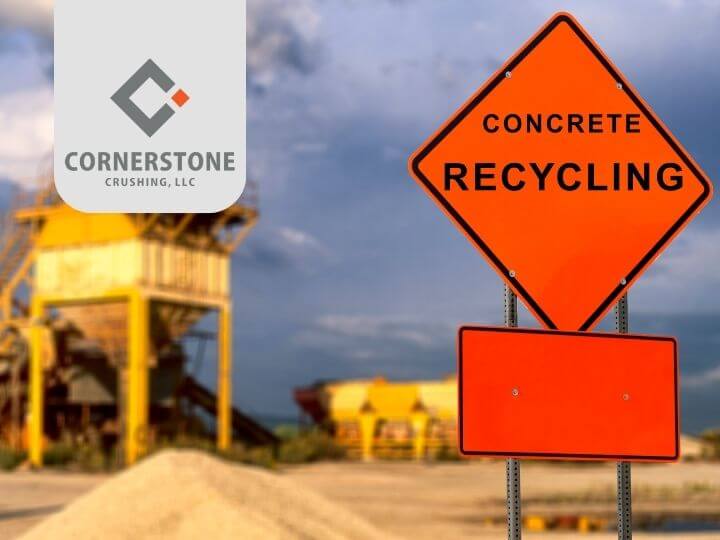Concrete is a widely used building material that has been the backbone of modern infrastructure for decades. However, the production and disposal of concrete waste pose significant environmental challenges. The concrete industry is one of the largest contributors to carbon dioxide emissions, and the disposal of concrete waste in landfills can have severe ecological impacts. As sustainability becomes an increasingly important issue in the construction industry, finding ways to recycle concrete waste is imperative. This article explores how concrete recycling technology can provide a sustainable solution to this problem, highlighting case studies and the role of Cornerstone Crushing in pioneering sustainable solutions.
The significance of concrete recycling cannot be overstated, given its potential to reduce environmental degradation and promote sustainable development. Concrete recycling refers to the process of breaking down old or unused concrete materials and repurposing them for use in new construction projects. This process not only saves valuable landfill space but also reduces the carbon footprint of the construction industry. In recent years, there have been significant innovations in concrete recycling technology, enabling the reuse of concrete waste in new construction projects. This article delves into the science behind these innovations and how they are transforming the construction industry into a more sustainable sector.
Understanding the Significance of Concrete Recycling
Concrete waste is a significant contributor to environmental degradation, with its production accounting for up to 8% of global carbon emissions. Besides the environmental impact, the cost of disposing of concrete waste is also economically burdensome. However, concrete recycling presents an opportunity to mitigate both environmental and economic challenges, as it provides a sustainable solution that transforms waste into a valuable resource.
Impacts of Concrete Waste on the Environment
The ecological repercussions of the disposal of concrete byproducts have been a subject of concern for environmentalists and policy-makers due to its potential to contaminate soil and water resources. The environmental impact of concrete pollution is significant, as it can contribute to the degradation of ecosystems and loss of biodiversity. The disposal of concrete waste has been a major challenge for the construction industry, as it generates a significant amount of waste that cannot be easily recycled or reused. Waste management solutions for concrete waste are necessary to reduce the negative impacts on the environment. Sustainable construction practices and eco-friendly alternatives such as using recycled aggregate and incorporating waste materials into new concrete mixes are promising solutions for reducing the environmental impact of concrete waste. It is crucial for the construction industry to adopt these practices to ensure a more sustainable future for our planet.
The Economic Benefits of Concrete Recycling
Concrete recycling has the potential to create significant economic benefits, particularly in terms of cost savings, job creation, and industry growth. By reducing the cost of raw materials and waste disposal, recycling concrete can lead to substantial savings for construction companies. Moreover, recycling concrete waste can also create new jobs in the recycling industry, which is increasingly becoming a critical part of the global economy. Additionally, the demand for sustainable building materials is on the rise, and recycled concrete is an excellent option that meets this need while also reducing environmental impact. As a result, the industry is poised for growth as more companies and governments recognize the value of concrete recycling. Overall, concrete recycling offers a sustainable solution that benefits both the environment and the economy, making it an essential component of the sustainable construction movement.
The Innovation behind Concrete Recycling Technology
The process of transforming concrete waste into reusable material has become an essential aspect of sustainable construction practices. Modern technology has played a critical role in enhancing concrete recycling to achieve optimal results. With the use of advanced equipment and techniques, concrete recycling has become an efficient and cost-effective solution for managing construction waste while reducing environmental impact.
Process of Transforming Concrete Waste into Reusable Material
The process of repurposing discarded concrete involves breaking it down into smaller pieces, sorting it by size and type, removing any contaminants, and then crushing it into a fine powder that can be used as a replacement for traditional building materials. Concrete waste management is a crucial aspect of sustainable construction materials, and the recycling process optimization can lead to environmental impact reduction and circular economy solutions. The transformation of concrete waste into reusable material requires careful planning and execution to ensure that the final product meets the required specifications for use in construction projects. The concrete recycling process is a highly technical and complex process that requires expertise and specialized equipment. However, it is a crucial step towards reducing waste and conserving natural resources by creating a closed-looped system. By repurposing concrete waste, we can reduce the environmental impact of construction activities, conserve natural resources, and create a more sustainable future for generations to come.
How Modern Technology is Enhancing Concrete Recycling
Innovative technological advancements have played a significant role in improving the efficiency and effectiveness of the concrete repurposing process, thereby reducing waste and ensuring sustainable construction practices. “Smart crushing” technology, for instance, is an advanced processing method that involves the use of specialized equipment to refine concrete into reusable particles. Innovative sorting techniques, combined with effective separation methods, are also being used to recover and recycle different concrete components, such as aggregates and cement. These technological solutions facilitate the production of high-quality recycled concrete that can be used in a wide range of construction applications. By reusing concrete waste, companies can not only save costs but also contribute to a more sustainable world through the reduction of greenhouse gas emissions and the conservation of natural resources. The integration of sustainable technologies is an essential step towards achieving a circular economy, and concrete recycling is a perfect example of how sustainable solutions can be achieved in the construction industry.
Real World Implications: Case Studies in Successful Concrete Recycling
This subtopic delves into the real-world implications of concrete recycling through case studies of successful projects. Specifically, this discussion will focus on the infrastructure built from recycled concrete, urban development, and sustainable city planning. The examples presented will demonstrate the practical application of concrete recycling technology and its contribution to sustainable development.
Examples of Infrastructure Built from Recycled Concrete
Infrastructure projects constructed using recycled concrete demonstrate the potential for repurposing waste materials as a viable alternative to traditional building practices. Recycled infrastructure is a sustainable construction solution that reduces the environmental impact of construction activities and promotes a circular economy by reducing waste. The use of recycled concrete in infrastructure projects has been successful in reducing the amount of waste sent to landfills and reducing the need for virgin materials. Examples of infrastructure built from recycled concrete include roads, bridges, and buildings. For instance, the I-10 Freeway in California was reconstructed using recycled concrete, which reduced the amount of waste sent to landfills by 100,000 tons. Similarly, the Green Building in New York City was constructed using recycled concrete, which reduced the need for virgin materials and saved 1,200 tons of carbon dioxide emissions. These examples demonstrate the potential for recycled infrastructure to be a sustainable and cost-effective solution for waste reduction and sustainable construction.
Urban Development and Sustainable City Planning
Urban development and sustainable city planning are critical factors in promoting environmentally conscious practices and reducing the negative impact of construction activities on the environment. Green infrastructure, transit-oriented development, renewable energy, sustainable transportation, and zero waste initiatives are all essential components of sustainable city planning. Green infrastructure involves the use of vegetation and natural systems to manage water, air, and soil quality in urban areas. Transit-oriented development promotes the use of public transportation and reduces reliance on personal vehicles, contributing to sustainable transportation practices. Renewable energy sources such as solar, wind, and hydropower help reduce dependence on fossil fuels and mitigate climate change. Sustainable transportation practices such as bike lanes, pedestrian walkways, and public transportation also contribute to reducing carbon emissions and promoting healthy lifestyles. Zero waste initiatives aim to reduce waste generation and promote recycling and composting to minimize landfill use. Overall, incorporating these elements into urban development and city planning can lead to a more sustainable future for our cities and the planet.
The Role of Cornerstone Crushing in Pioneering Sustainable Solutions
Cornerstone Crushing has been consistently pioneering sustainable solutions in the Greater Toledo, Ohio area for over a decade. Our proven track record is a testament to our unwavering commitment to providing high-quality and efficient services to our clients. We assure this by adhering to strict standards and utilizing state-of-the-art equipment and techniques to ensure that our clients receive the best possible results.
Our Proven Track Record in the Greater Toledo, Ohio Area
The successful implementation of our concrete waste repurposing initiative in the Greater Toledo, Ohio area attests to the effectiveness and feasibility of our approach in mitigating environmental degradation and resource depletion. Toledo’s success in this initiative is largely due to the local impact and community involvement, as our partnership with local businesses and organizations has allowed us to recycle thousands of tons of concrete waste, reducing landfill waste and preserving natural resources. Through our sustainable partnerships, we have been able to create a circular economy, where waste is repurposed into new materials and resources. Our future plans include expanding our reach to other cities and regions, further reducing waste and improving sustainability practices. With the support of engaged communities, we are confident that our approach to repurposing concrete waste can be replicated in other areas, creating a more sustainable future for all.
How We Assure Quality and Efficiency in Our Services
Building on our track record of success in the Greater Toledo, Ohio area, we are committed to delivering high-quality and efficient services to our clients. Our approach to quality assurance involves implementing strict measures to ensure that every aspect of our work meets the highest standards. We use performance metrics to track our progress and identify areas for improvement, and we are constantly striving to enhance our processes to increase efficiency and effectiveness. Our focus on customer satisfaction is central to our mission, and we are dedicated to providing our clients with the best possible experience. Through continuous improvement, we are able to stay ahead of the curve and offer innovative solutions that meet the changing needs of our clients. At our core, we are driven by a passion for sustainability and a commitment to transforming concrete waste into a sustainable success story.
Cornerstone Crushing: Your Trusted Partner in Concrete Recycling
Cornerstone Crushing offers a unique value proposition that sets it apart from competitors in the concrete recycling industry. Our commitment to sustainability, combined with our state-of-the-art equipment and highly experienced team, ensures that we provide our clients with the highest quality service and products. Contact us today to join us in building a sustainable future together.
Why Choose Cornerstone Crushing: Our Unique Value Proposition
By offering a distinctive value proposition, Cornerstone Crushing stands out among its competitors in the concrete crushing industry. Their sustainable practices not only reduce the environmental impact of concrete waste, but also provide cost effectiveness for clients. With industry expertise and a focus on client satisfaction, Cornerstone Crushing delivers high-quality service that is both reliable and efficient. Their commitment to sustainability is evident in their use of modern equipment and techniques that minimize dust and noise pollution. This, coupled with their focus on safety, makes them a valuable partner for any project in need of concrete recycling.
Contact Us Today: Let’s Build a Sustainable Future Together
This section offers an opportunity to learn more about Cornerstone Crushing’s commitment to sustainability and how they can assist in building a sustainable future through their services. As a sustainable partner in the construction industry, Cornerstone Crushing values the importance of green construction and waste reduction. They recognize that the construction industry is one of the largest producers of waste globally, and they aim to reduce this waste by transforming concrete waste into sustainable success. Their eco-friendly innovation aligns with the principles of the circular economy, where waste is viewed as a valuable resource that can be reused and recycled. By partnering with Cornerstone Crushing, clients can contribute to creating a more sustainable future through the reduction of waste and the use of recycled materials. Contact them today to see how they can help build a sustainable future together.
Frequently Asked Questions
What are the environmental benefits of concrete recycling compared to traditional disposal methods?
Concrete recycling offers a range of environmental benefits when compared to traditional disposal methods. Reduced emissions of greenhouse gases, including carbon dioxide, are a key advantage of concrete recycling, as the process of manufacturing new concrete produces a significant amount of carbon emissions. Landfill reduction is also a critical environmental benefit, as concrete waste accounts for a significant proportion of construction and demolition waste. Recycling concrete instead of disposing of it in landfills helps to conserve resources, reduce landfill space, and promote sustainable construction practices. Furthermore, concrete recycling provides circular economy opportunities, where waste materials can be repurposed and reused in new construction projects, reducing the need for virgin materials and minimizing the overall environmental impact of construction activities.
How does the cost of concrete recycling compare to traditional disposal methods?
Cost comparison between traditional disposal methods and concrete recycling is a crucial consideration for determining the economic feasibility of the latter. Concrete recycling is a sustainable solution that not only reduces waste but also utilizes resources efficiently. Recycling efficiency is critical in reducing the overall cost of the process, which can be further offset by the revenue generated from selling recycled aggregates. Furthermore, the cost of traditional disposal methods can be high due to transportation, landfill fees, and other associated costs. In contrast, concrete recycling reduces transportation costs by recycling on-site, while the recycled aggregates can be used in construction projects, reducing the need for virgin materials. Therefore, given the cost-saving benefits and environmental advantages, concrete recycling is a viable option for waste reduction and sustainable resource utilization.
Are there any limitations to the types of concrete waste that can be recycled?
Recyclable concrete types, recycling limitations, sorting methods, processing techniques, and quality standards are all critical factors that affect the success of concrete waste recycling. The type of concrete waste being recycled determines the processing techniques that must be employed to ensure that the materials are sorted effectively and meet quality standards. However, there are limitations to the types of concrete waste that can be recycled, such as the presence of contaminants. Sorting methods, such as manual sorting and magnetic separation, are crucial in removing contaminants and ensuring that the recycled concrete is of high quality. Processing techniques, including crushing and screening, are used to transform the concrete waste into an acceptable form for reuse. Quality standards for recycled concrete are also essential to ensure that the end product matches the required specifications and can be used in construction projects. Overall, a combination of effective sorting methods and processing techniques is necessary to ensure that the recycling of concrete waste is successful and sustainable.
What regulations are in place to ensure safe and sustainable concrete recycling practices?
Regulatory compliance, safety guidelines, waste management, resource conservation, and sustainable practices are all essential factors in ensuring safe and sustainable concrete recycling practices. Several regulations are in place at the federal, state, and local levels to ensure that concrete recycling facilities adhere to strict guidelines to protect the environment and public health. These regulations require facilities to obtain permits, follow waste management practices, and undergo regular inspections to ensure compliance. Safety guidelines are also in place to protect workers from potential hazards while handling and processing concrete waste. Additionally, resource conservation plays a critical role in sustainable concrete recycling practices. Facilities must aim to recover as much material as possible from the waste stream while minimizing waste generation. By following these guidelines, concrete recycling facilities can ensure that their operations are sustainable and contribute to the circular economy.
How can individuals and businesses contribute to the growth of the concrete recycling industry?
Community involvement, education programs, infrastructure investment, waste reduction initiatives, and industry partnerships are all crucial factors in contributing to the growth of the concrete recycling industry. Community involvement can help raise awareness and promote the benefits of concrete recycling, while education programs can provide individuals and businesses with the knowledge and skills needed to properly recycle concrete waste. Infrastructure investment can help create the necessary facilities and equipment for concrete recycling, while waste reduction initiatives can help reduce the amount of concrete waste generated in the first place. Finally, industry partnerships can help foster collaboration and innovation in the concrete recycling industry, leading to more sustainable and efficient practices. By working together and implementing these strategies, individuals and businesses can help drive the growth of the concrete recycling industry and contribute to a more sustainable future.
Conclusion
Concrete recycling has become an increasingly important topic in the world of sustainability, as the need for more eco-friendly solutions continues to grow. The process of recycling concrete waste not only reduces the amount of waste that ends up in landfills, but also saves energy and reduces greenhouse gas emissions. This article has explored the significance of concrete recycling, the innovative technology behind it, and real world examples of successful implementations.
One of the key players in the concrete recycling industry is Cornerstone Crushing, a trusted partner that has pioneered sustainable solutions. By offering mobile crushing services, Cornerstone Crushing can efficiently and effectively recycle concrete on-site, reducing transportation costs and minimizing environmental impact. As more and more companies become aware of the benefits of concrete recycling, the demand for services like those provided by Cornerstone Crushing is sure to continue to grow.
In conclusion, concrete recycling is not only important for the environment, but also for the economy. By reducing waste and saving energy, it offers a sustainable solution that benefits everyone. With innovative technology and trusted partners like Cornerstone Crushing leading the way, the future of concrete recycling looks bright.


